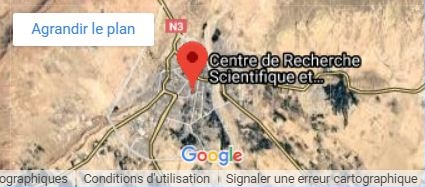About Us
The Scientific and Technical Research Center for Arid Regions "Omar EL-BERNAOUI" (C.R.S.T.R.A.) is a Public Establishment of a Scientific and Technical Nature (E.P.S.T.). It was established by Decree No. 91-478 of December 14, 1991, modified and supplemented by Decree No. 03-458 of December 1, 2003, and governed by Executive Decree No. 11-396 of November 24, 2011, which defines the standard status of public scientific and technological establishments. This center, endowed with legal personality and financial autonomy, operates under the supervision of the Ministry of Higher Education and Scientific Research.
CRSTRA's Missions
The center is responsible for:
- Conducting Scientific and Technical Research Programs on Arid Regions and/or areas threatened by drought or desertification.
- Undertaking and/or participating in multidisciplinary research related to Arid Regions.
- Establishing a scientific and technical database on Arid Regions and ensuring its processing, preservation, and dissemination.
- Participating in research aimed at understanding and combating human vulnerability to environmental changes.
Research Strategies
CRSTRA is responsible for developing scientific and technical research and maintaining ecological monitoring through continuous observation and the creation of a scientific and technical database for arid and semi-arid territories (Saharan and steppe regions), which cover more than 2 million km², accounting for over 85% of the national territory.
After conducting an in-depth diagnosis of research activities at CRSTRA, evaluating their impact on the development of these regions, and considering the multiple and complex missions assigned to it, as well as the vastness, diversity, potential, and vulnerability of arid ecosystems, it became necessary—even imperative—to develop a dedicated research strategy. This strategy aims to address the challenges of these environments by prioritizing thematic and spatial issues.
In alignment with the expressed political will and the goal of sustainable development in arid regions, we took the opportunity to conduct an evaluation with a group of experts to ensure our activities align with this major objective.
As a result, key strategic priority areas were defined in April 2006, along with a preliminary development plan for the center. This plan includes a physical institutional presence in the concerned territories through a network of observatories and technology transfer hubs.
Strategic Orientation Axes
Based on an objective analysis of the situation and the identification of sectoral, territorial, socio-economic, and scientific challenges, the think tank has identified five major axes:
Activities
- Implementation of National Research Programs for the Development of Arid Regions in the following fields:
- Environment
- Major Risks
- Territorial Planning
- Water Resources
- Agriculture, Rural Development, and Socioeconomic Development
- Renewable Energies
- Specific expertise and engineering studies
- Accelerated courses in the center’s fields of interest
- Organization of seminars, workshops, and other scientific meetings related to its missions
- Ecological and technological monitoring in Arid Regions
- Scientific publishing:
- International journal: “Algerian Journal of Arid Regions”
- Scientific books
- Scientific films and videos
- Conference proceedings
- Doctoral, Master’s, Engineer, and DES theses
- Cartographic documents
- Technical data sheets
Biskra
Located at the foot of the southern slope of the Aurès massif, at the confluence of two valleys that cross this mountain range, Biskra serves as the first gateway to the Saharan region in eastern Algeria.
In addition to its water and soil resources, which have enabled oasis agriculture, this strategic position has made Biskra a natural hub for North-South circulation.
Since Roman times, this site has been used by successive occupants as a stronghold, administrative center, and commercial hub.
This provincial capital, with a population of 59,000 in 1966, reached 178,064 in the last census (1998), tripling within three decades.
The city boasts an important university center and a significant date palm industry. It is also equipped with an international airport connecting it to the capital and foreign destinations.

